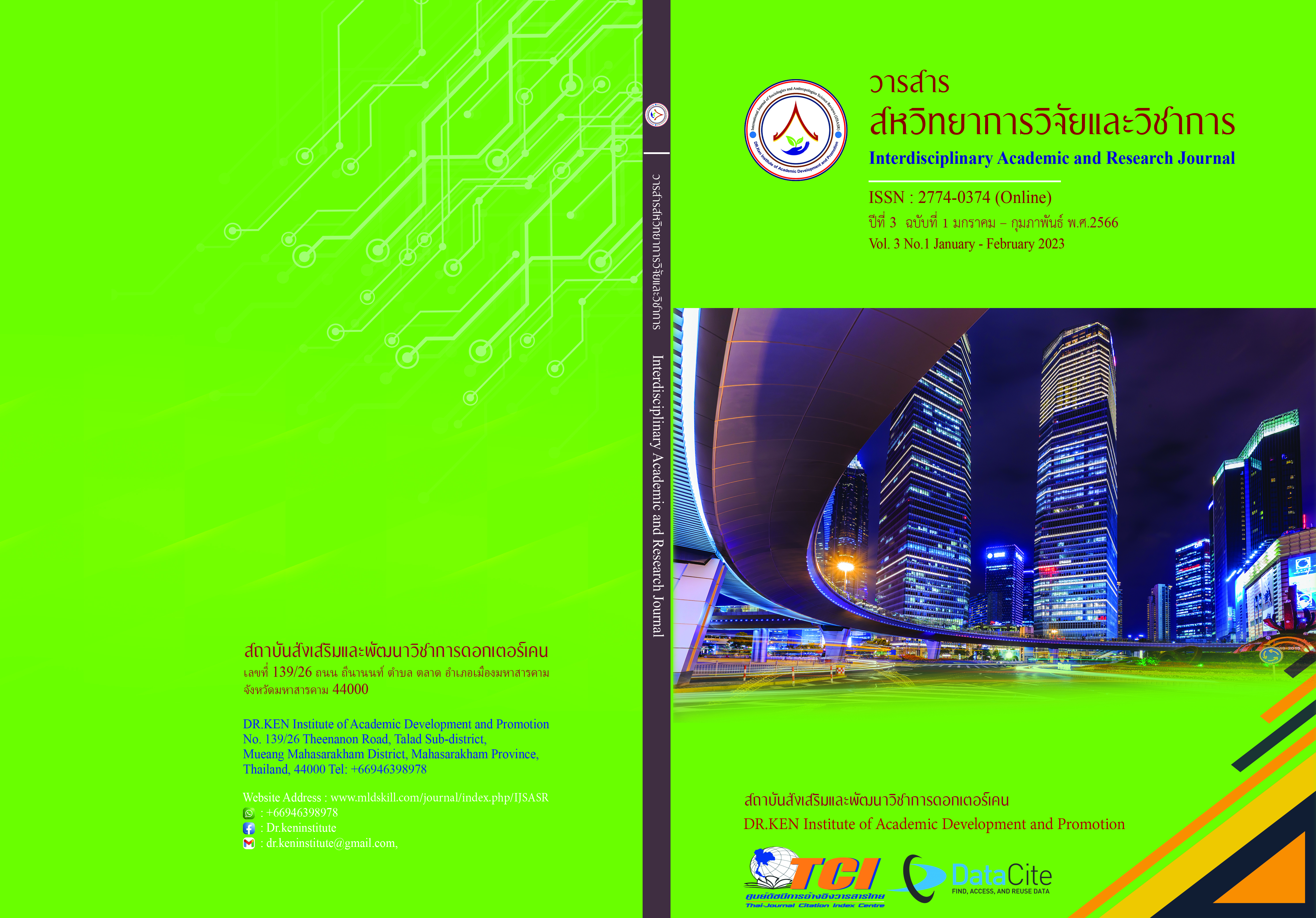Social Innovations of Chaiyaphum Province
DOI:
https://doi.org/10.14456/iarj.2023.6Keywords:
Social Innovation; , Chaiyaphum ProvinceAbstract
Social innovation to promote lifelong learning is the creation of a knowledgeable and intellectual society under the important guidelines of the national education plan. It is a process of co-creation between members of the social unit that coexists to cause learning, invention, and setting up of social practices. The purpose of this study was to study social innovations for promoting lifelong learning in Chaiyaphum Province. The samples were selected from the communities in the following subdistricts: Huai Ton Subdistrict, Na Fai Subdistrict, Ban Lao Subdistrict, Na Siao Subdistrict, Nong Na Saeng Subdistrict, Nai Mueang Subdistrict, Huai Bong Subdistrict, Phon Thong Subdistrict, Lat Yai Subdistrict, Tha Hin Ngom Subdistrict, Chaiyaphum Province. Three samples were selected by a purposive sampling method from each community. They were the representatives of people in each age range: children, adolescents, and older persons in 10 communities. So, there were 30 samples and 3 experts in educational management. A data collection instrument was the interview form on social innovations for promoting community lifelong learning. Data were collected through interviews. The findings revealed that in the target communities, there are learning centers, community enterprises, and local philosophers who are the sources of learning for people in the community. Also, the social innovations related to lifelong learning are consistent with the way of life or occupations of people in the community and the resources available in the community. Social innovations for promoting lifelong learning in Chaiyaphum Province include the formation of learning groups, and weaving group groups for developing professional skills, such as the silk production group, the weaving group of the handicapped, the knife-making group, the food processing group (powdered rice drinking, germinated Hang rice), the organic vegetable planting group and the herbal product group.
References
ไกรยส ภัทราวาท. (2559). เดินหน้าการศึกษาไทยอย่างไรให้ตอบโจทย์ Thailand Economy 4.0. Retrieved from: http://www.manager.co.th/QOL/ViewNews.aspx?NewsID=9590000069668
กลุ่มยุทธศาสตร์กำลังคนในระบบการอุดมศึกษา วิทยาศาสตร์ วิจัยและนวัตกรรม. (2563). รายงานการศึกษา การส่งเสริมการเรียนรู้ตลอดชีวิต (Lifelong learning) เพื่อรองรับการพลิกแบบฉับพลันและวิกฤตการณ์โลก. สำนักงานสภานโยบายการอุดมศึกษา วิทยาศาสตร์ วิจัยและนวัตกรรมแห่งชาติ.
กัลยา ติงศภัทิย์. (2557). “เส้นทางสู่ศตวรรษที่ 2” การสัมมนาทางวิชาการ เรื่อง ขอบแดนใหม่แห่งการเรียนรู้การศึกษาระบบ 4.0 (New Frontier of Learning : Education 4.0). ศูนย์นวัตกรรมการเรียนรู้จุฬาลงกรณ์มหาวิทยาลัย.
จันทร์ศรี สิมสินธุ์. (2558). นวัตกรรมชุมชนเพื่อการเรียนรู้ตลอดชีวิต. ปริญญานิพนธ์ปรัชญาดุษฎีบัณฑิต สาขานวัตกรรมเพื่อการพัฒนาท้องถิ่น: มหาวิทยาลัยราชภัฏมหาสารคาม.
ชานนท์ โกมลมาลย์. (2561). นวัตกรรมทางสังคมเพื่อขับเคลื่อนสุขภาวะโดยการมีส่วนร่วมของเด็กและเยาวชน. วารสารสังคมสงเคราะห์ศาสตร์, 26 (1), 120-145.
ธีรวัฒน์ เหล่าสมบัติ. (2560). นวัตกรรมเพื่อสังคม (Social Innovation). Retrieved from: https://social.nia.or.th/2019/article0001/
ธีรศักดิ์ อุ่นอารมณ์เลิศ และคณะ. (2558). การพัฒนารูปแบบการสร้างนวัตกรรมภูมิปัญญาเศรษฐกิจพอเพียงเพื่อเสริมสร้างศักยภาพในการแข่งขันอย่างยั่งยืนของวิสาหกิจชมชนกลุ่มแปรรูปผลิตภัณฑ์ กลุ่มจังหวัดภาคกลางตอนล่าง. วารสารศิลปากรศึกษาศาสตร์วิจัย, 7 (2), 79-92.
ปาน กิมปี. (2557). “การประกันคุณภาพการศึกษานอกระบบและการศึกษาตามอัธยาศัย.การศึกษาและการเรียนรู้ตลอดชีวิต”. ใน สุวิธิดา จรุงเกียรติกุล (บก.). การศึกษาและการเรียนรู้ตลอดชีวิต (หน้า 121 - 143). กรุงเทพฯ : ศูนย์ส่งเสริมการพัฒนานวัตกรรมตำราและเอกสารทางวิชาการ จุฬาลงกรณ์มหาวิทยาลัย.
ปิยากร หวังมหาพร. (2552).นวัตกรรมการเรียนรู้ตลอดชีวิตของสหภาพยุโรป. ศูนย์ยุโรปศึกษา จุฬาลงกรณ์มหาวิทยาลัย.
พิณสุดา สิริธรังศรี. (2553). ภาพการศึกษาไทยในอนาคต 10 -20 ปี. พิมพ์ครั้งที่ 2. กรุงเทพฯ :พิมพ์ดีการพิมพ์.
วิจารณ์ พานิช. (2555). วิถีสร้างการเรียนรู้เพื่อศิษย์ในศตวรรษที่ 21. กรุงเทพฯ : มูลนิธิสดศรี – สฤษดิ์วงศ์.
สำนักงานเลขาธิการสภาการศึกษา กระทรวงศึกษาธิการ. (2549). การศึกษาเปรียบเทียบการพัฒนาการศึกษาไทยกับนานาชาติ : นวัตกรรมด้านการเรียนรู้ตลอดชีวิตเพื่อยกระดับการศึกษาของแรงงานไทย. กรุงเทพฯ : พริกหวานกราฟฟิค.
อาชัญญา รัตนอุบล. (2554). แนวคิดการเรียนรู้ด้วยการนำตนเองสู่การเรียนรู้ตลอดชีวิต. ใน ณัฏฐลักษณ์ ศรีมีชัย (บก.). ความเป็นผู้นำทางการศึกษานอกระบบและการศึกษาตามอัธยาศัย. กรุงเทพฯ : จุฬาลงกรณ์มหาวิทยาลัย.
Clayton, W., & Elasy, T. A. (2009). A review of the pathophysiology, classification and treatment of foot ulcers in diabetic patients. Feature Article, 27 (2), 52-58
Howaldt, J., & Schwarz, M. (2010). Social Innovation: Concepts, Research Fields and International Trends. Dortmund: International Monitoring. Retrieved from: http://www.sfs.tudortmund.de/cms/Medienpool/small_publications/Doc_1289_IMO_Trendstudie_Howaldt_Schwarz_englische_Version.pdf
Mulgan, G., Tucker, S., Ali, R., & Sanders, B. (2007). Social Innovation: What It Is, Why It Matters and How It Can be Accelerated. Retrieved from: https://youngfoundation.org/wp-content/uploads/2012/10/Social-Innovation-what-it-is-why-it-matters-how-it-can-be-accelerated-March-2007.p
Murray, R., Caulier-Grice, J., & Mulgan, G. (2008). Generating Social Innovation: Setting an Agenda, Shaping Methods and Growing the Field. Retrieved from: https://youngfoundation.org/wp- content/uploads/2012/10/The-Open-Book-of- Social- Innovationg.pdf
Phills, D. M. (2008). Rediscovering Social Innovation. Stanford Social Innovation Review. 6 (4), 34-43. Retrieved from: https://www.researchgate.net/publication/242511521_Rediscovering_Social_Innovation
Downloads
Published
How to Cite
Issue
Section
License
Copyright (c) 2023 สุนันท์ สีพาย, นิลรัตน์ โคตะ, สกาวเดือน ไชยสา

This work is licensed under a Creative Commons Attribution-NonCommercial-NoDerivatives 4.0 International License.
Copyright on any article in the Interdisciplinary Academic and Research Journal is retained by the author(s) under the under the Creative Commons Attribution-NonCommercial-NoDerivatives 4.0 International License. Permission to use text, content, images, etc. of publication. Any user to read, download, copy, distribute, print, search, or link to the full texts of articles, crawl them for indexing, pass them as data to software, or use them for any other lawful purpose. But do not use it for commercial use or with the intent to benefit any business.
















.png)


